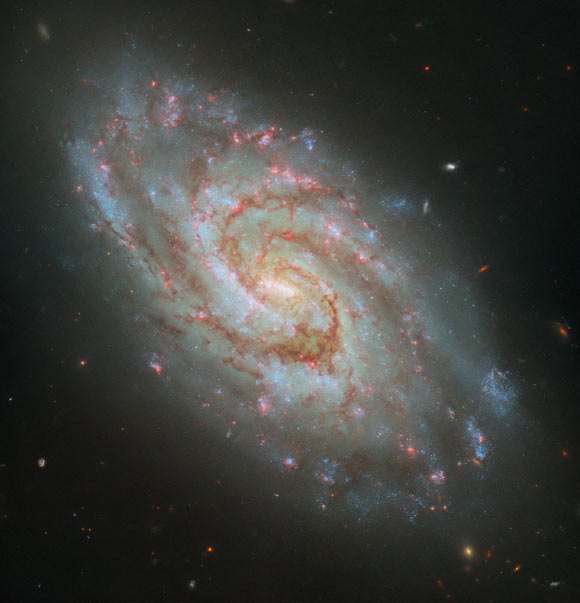
The Hubble team has released a stunning new image snapped by the NASA/ESA Hubble Space Telescope of the barred spiral galaxy IC 1954.

This Hubble image shows IC 1954, a small barred spiral galaxy located 45 million light-years away in the constellation of Horologium. Image credit: NASA / ESA / Hubble / D. Thilker / J. Lee / PHANGS-HST Team.
IC 1954 lies some 45 million light-years away from Earth in the southern constellation of Horologium.
This small spiral galaxy was discovered in 1898 by the Scottish astronomer Robert Innes.
Otherwise known as ESO 200-36, IRAS 03300-5204 or LEDA 13090, it has a diameter of 20,000 light-years.
IC 1954 has a bright central bar and lazily winding spiral arms threaded with dark clouds of dust.
Together with four other galaxies, it forms the LGG 93 galaxy group, also known as the IC 1954 group.
“IC 1954 sports a glowing bar in its core, two main majestically winding spiral arms and clouds of dark dust across it,” the Hubble astronomers said in a statement.
An image of IC 1954 was previously released by the Hubble team in 2021. The new image now includes H-alpha data.
“The improved coverage of star-forming nebulae, which are prominent emitters of the red H-alpha light, can be seen in the numerous glowing, pink spots across the disk of the galaxy,” the researchers said.
“Interestingly, some astronomers posit that the galaxy’s ‘bar’ is actually an energetic star-forming region that just happens to lie over the galactic center.”
The color image of IC 1954 was made from separate exposures taken in the visible, ultraviolet and near-infrared regions of the spectrum with Hubble’s Wide Field Camera 3 (WFC3).
Six filters were used to sample various wavelengths. The color results from assigning different hues to each monochromatic image associated with an individual filter.
“By surveying IC 1954 and over fifty other nearby galaxies in radio, infrared, optical, and ultraviolet light, astronomers aim to fully trace and reconstruct the path matter takes through stars and the interstellar gas and dust in each galaxy,” the scientists said.
“Hubble’s observing capabilities form an important part of this survey: it can capture younger stars and star clusters when they are brightest at ultraviolet and optical wavelengths, and its H-alpha filter effectively tracks emission from nebulae.”
“The resulting dataset will form a treasure trove of research on the evolution of stars in galaxies, which the NASA/ESA/CSA James Webb Space Telescope will build upon as it continues its science operations into the future.”
 Print
Print


